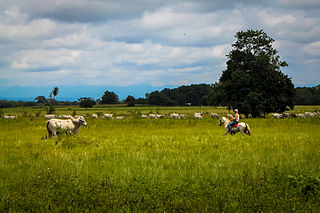
Portuguesa State is one of the 23 states of Venezuela. Located in the west of the Republic, it is often considered the "breadbasket of Venezuela" for the large amount of agricultural products produced there. The state is bordered by the state of Lara to the north, to the east by Cojedes, to the west by Trujillo and to the south by Barinas.
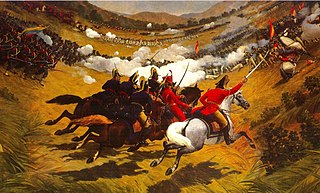
The Venezuelan War of Independence was one of the Spanish American wars of independence of the early nineteenth century, when independence movements in South America fought a civil war for secession and against unity of the Spanish Empire, emboldened by Spain's troubles in the Napoleonic Wars.
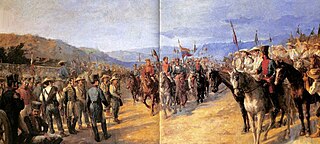
Bolívar's campaign to liberate New Granada also known as the Liberation Campaign of 1819 was part of the Colombian and Venezuelan wars of independence and was one of the many military campaigns fought by Simón Bolívar. In 1819 Bolívar led a combined New Granadan and Venezuelan Army in a campaign to liberate New Granada which had been under Spanish control since 1816.

The Battle of Boyacá (1819), also known as the Battle of Boyacá Bridge was a decisive victory by a combined army of Venezuelan and New Granadan troops along with a British Legion led by General Simon Bolivar over the III Division of the Spanish Expeditionary Army of Costa Firme commanded by Spanish Colonel José Barreiro. This victory ensured the success of Bolívar's campaign to liberate New Granada. The battle of Boyaca is considered the beginning of the independence of the north of South America, and is considered important because it led to the victories of the battle of Carabobo in Venezuela, Pichincha in Ecuador, and Junín and Ayacucho in Peru. New Granada acquired its definitive independence from the Spanish Monarchy, although fighting with royalist forces would continue for years.

The Battle of Carabobo, on 24 June 1821, was fought between independence fighters, led by Venezuelan General Simón Bolívar, and the Royalist forces, led by Spanish Field Marshal Miguel de la Torre. Bolívar's decisive victory at Carabobo led to the independence of Venezuela and establishment of the Republic of Gran Colombia.

The Battle of Ayacucho was a decisive military encounter during the Peruvian War of Independence. This battle secured the independence of Peru and ensured independence for the rest of belligerent South American states. In Peru it is considered the end of the Spanish American wars of independence in this country, although the campaign of Antonio José de Sucre continued through 1825 in Upper Peru and the siege of the fortresses Chiloé and Callao eventually ended in 1826.

José Antonio Anzoátegui (1789–1819) was a Venezuelan military officer who fought in the Venezuelan and Colombian Wars of Independence.

The Admirable Campaign was a military action led by Simón Bolívar in which the provinces of Mérida, Barinas, Trujillo and Caracas were conquered by the Patriots. Its objective was to free Venezuela from Spanish control, which was accomplished in conjunction with Santiago Mariño's simultaneous campaign in the east.

Santiago Mariño Carige Fitzgerald, was a nineteenth-century Venezuelan revolutionary leader and hero in the Venezuelan War of Independence (1811–1823). He became an important leader of eastern Venezuela and for a short while in 1835 seized power over the new state of Venezuela.
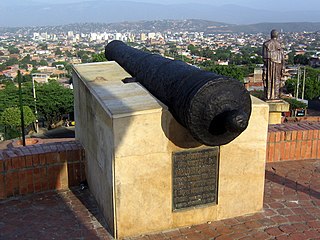
The Battle of Cúcuta was a military conflict in the Spanish American wars of independence fought on 28 February 1813 between the pro-independence forces led by Simón Bolívar and Spanish royalist troops under General Ramón Correa at the town of Cúcuta, in present-day Colombia, close to the border with Venezuela. Bolivar was victorious. The battle gained him much support and immediately preceded his march into Venezuela, later dubbed the Admirable Campaign.

Antonio Clemente José María Bernabé Ricaurte Lozano was a patriot of the Independence of Colombia and Venezuela and captain of Bolívar's army. He is remembered as the martyr of the Battle of San Mateo, where, in a heroic action, he blasted an enemy stronghold by immolating himself.

Juan Domingo de Monteverde y Rivas, commonly known as Domingo de Monteverde, was a Spanish soldier, governor and Captain General of Venezuela from June 1812 to 8 August 1813. Monteverde was the leader of Spanish forces in the Venezuelan War of Independence from 1812 to 1813. Monteverde led the military campaign that culminated in the fall of the First Republic of Venezuela in 1812. One year later in 1813, Monteverde was defeated by Simón Bolívar during the Admirable Campaign.
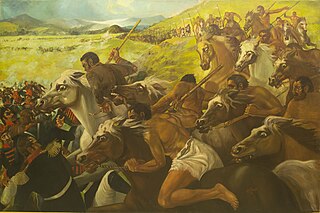
The Battle of Vargas Swamp fought on July 25, 1819, was an engagement of Bolívar's campaign to liberate New Granada. The battle involved a joint Venezuelan and Neogranadine army commanded by General Simón Bolívar against the III Division of the Spanish Royalist Army commanded by Colonel José María Barreiro. The Battle of Vargas Swamp is considered one of the most important battles of the Colombian War of Independence as it cleared the path for the Patriot army to advance towards Santafé de Bogotá, while also demoralizing the Royalist troops. Vargas Swamp was also the bloodiest battle of the 1819 New Granadan liberation campaign.
The First Battle of Carabobo (1814) was a battle in the Venezuelan War of Independence, in which the forces of the Second Republic, commanded by Simón Bolívar, defeated the Spanish forces under Field marshal Juan Manuel de Cajigal y Martínez.

The Battle of Los Horcones, part of the Admirable Campaign, was a military conflict in Venezuela during the Spanish American wars of independence fought on 22 July 1813 between the pro-independence forces led by José Félix Ribas and Spanish Royalist troops under colonel Francisco Oberto at the plain of Los Horcones. Ribas was victorious, capturing much of the Spanish equipment and more than 300 prisoners.
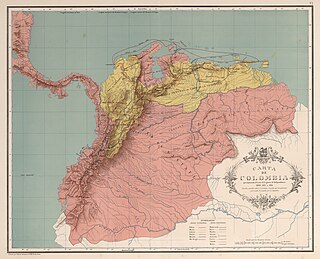
The Magdalena campaign was a military operation from late 1812 to early 1813, led by the independentists Simón Bolívar and Pierre Labatut against royalists and the crown of Spain in New Granada. The campaign resulted in the revolutionary United Provinces of New Grenada taking control of the Magdalena River, which connects the port city of Cartagena with the interior of Colombia.
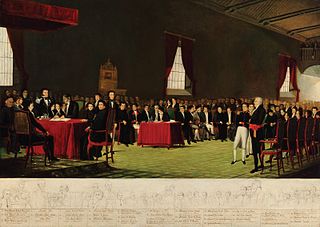
The Venezuelan independence was the juridical-political process that put an end to the ties between the Captaincy General of Venezuela and the Spanish Empire. It also implied the replacement of the absolute monarchy by the republic as the form of government in Venezuela.
The Battle of Clarines took place during the Venezuelan War of Independence. Royalist forces attacked a north-bound force from the Third Republic of Venezuela near the town of Clarines. The outnumbered and poorly armed Royalists secured a victory against the Patriot rebels.

The Battle of Aragua de Barcelona was fought between Royalists of the Spanish Empire and the Second Republic of Venezuela on 17 August 1814. The battle saw Royalists attack Simón Bolívar's force of 3,000 and win with their 8,000 soldiers. It was a major loss for the Patriots.
José Ceballos was a Spanish Brigadier during the Venezuelan War of Independence and Governor of Coro Province in Venezuela in 1810 at the outbreak of the revolution.
















